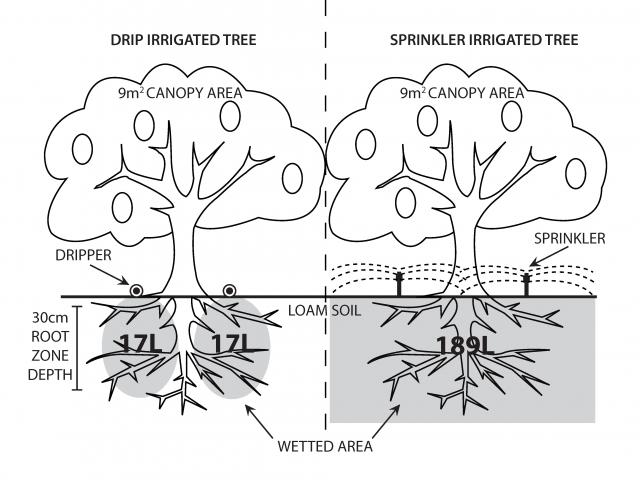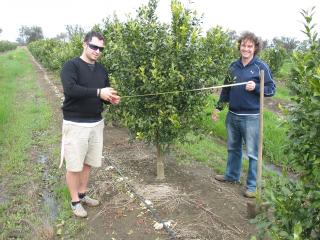Introduction
Irrigation scheduling — knowing how much water to put on and when — has a direct impact on tree health and fruit yield, size and quality.
Correct irrigation scheduling requires an understanding of how much water:
-
can be held in the crop root zone
-
is required by the crop each day
-
is applied by the irrigation system.
Shallow root systems
Citrus trees have shallow root systems. Dig under the canopy of a tree in an area watered by your irrigation system and you will see a mass of fine roots. Dig a little deeper and these fine roots are replaced by larger, structural roots. It is the mass of fine roots — the effective root zone — that takes up most of the water and nutrients.
Irrigation must be aimed at the effective root zone, minimising the amount of water wasted. For citrus, the effective root zone is usually the top 30 to 40cm, depending on soil type.
Root zone capacity
The amount of water that can be held in the root zone varies with the type of irrigation system used, soil type, depth of the effective root zone and proportion of stone or gravel in the soil.
Figure 1 shows two trees of the same size (9 square metre canopy area), growing in a hedgerow in a loam soil. The root zone of both trees is 30cm deep. One tree is irrigated with two drippers, the other with a fully overlapping micro-sprinkler system. The soil within the wetted root zone of the tree with the two drippers can hold 34 litres of Readily Available Water, much less than the comparable sprinkler-irrigated tree where the root zone can hold 189 litres.
Figure 1 Example of water-holding capacity under different irrigation systems
Daily water requirements
There is good correlation between plant water requirements and evaporation. Citrus trees use about 70% of evaporation. If evaporation is 10mm, the trees will use 7mm of water from the soil root zone volume.
Daily water use (mm) = Evaporation (mm) x 0.7
If you use sprinkler systems which irrigate the under-canopy area evenly with a known application rate, use this formula to calculate daily water requirements.
Drip irrigation systems only water a portion of the under-canopy area so daily water requirements should be calculated in litres.
Converting water use to litres
To convert millimetres of water use to litres, multiply daily water use in millimetres by the canopy area at ground level.
Daily water use (L) = Evaporation (mm) x 0.7 x Canopy ground area (m2)
Water use is proportional to the area of exposed leaf, which relates to the area of land covered by the canopy. Calculate canopy ground area in square metres by measuring the horizontal dimensions. If the trees are growing in a hedge and canopies are touching, multiply the tree spacing by the average canopy width along the row. If the canopies do not touch, work out the area as a circle.
Measuring canopy size
Tables 1 and 2 show the average daily irrigation requirements of citrus trees in litres for different canopy sizes at Wokalup and the Upper Swan. Figures have been rounded. Average evaporation rates were taken from the Bureau of Meteorology website.
| Jan | Feb | Mar | Apr | May | Jun | Jul | Aug | Sep | Oct | Nov | Dec | ||
|---|---|---|---|---|---|---|---|---|---|---|---|---|---|
| Average monthly evaporation (E) | — | 9 | 8.6 | 6.8 | 4.4 | 2.7 | 2.1 | 2.3 | 2.5 | 3.2 | 4.4 | 6 | 7.9 |
| Small tree 1m² canopy (E x 0.7 x 1m²) | Average daily irrigation requirement (L/tree) | 6.5 | 6 | 5 | 3 | 2 | 1.5 | 1.5 | 2 | 2.5 | 3 | 4.5 | 5.5 |
| Medium tree 9m² canopy (E x 0.7 x 9m²) | 57 | 54 | 43 | 28 | 17 | 13 | 14.5 | 16 | 20 | 28 | 38 | 50 | |
| Large tree 16m² canopy (E x 0.7 x 16m²) | 101 | 96.5 | 76 | 49 | 30 | 23.5 | 26 | 28 | 36 | 49.5 | 67 | 88.5 |
| Jan | Feb | Mar | Apr | May | Jun | Jul | Aug | Sep | Oct | Nov | Dec | ||
|---|---|---|---|---|---|---|---|---|---|---|---|---|---|
| Average monthly evaporation (E) | 9.9 | 9.1 | 7.3 | 5 | 3.1 | 2.5 | 2.5 | 2.6 | 3.3 | 4.8 | 6.7 | 8.5 | |
| Small tree 1m² canopy (E x 0.7 x 1m²) | Average daily irrigation requirement (L/tree) | 7 | 6.5 | 5 | 3.5 | 2.5 | 2 | 2 | 2 | 2.5 | 3.5 | 5 | 6 |
| Medium tree 9m² canopy (E x 0.7 x 9m²) | 62.5 | 57.5 | 46 | 31.5 | 20 | 16 | 16 | 16.5 | 21 | 30 | 42 | 53.5 | |
| Large tree 16m² canopy (E x 0.7 x 16m²) | 111 | 102 | 82 | 56 | 35 | 28 | 28 | 29 | 37 | 54 | 75 | 95 |
Imperial mandarins
Varieties with narrow, upright growth habits, such as Imperial mandarins, will require slightly more water than that calculated according to canopy ground area. Use the calculations above as a base and fine-tune the schedule using soil moisture monitoring.
Scheduling irrigation
To schedule irrigation, compare the amount of water available in the crop root zone with the tree’s daily water requirement. If the daily water requirement exceeds the amount of water that can be held in the root zone, irrigate more than once a day. If the soil can hold more than the daily water requirement, irrigate when the available water is depleted. This may be every second or third day, daily or several times a day.
Example
Using the example in Figure 1, on an average day in January in the Upper Swan area these trees would require 62.5 litres of water. The drip-irrigated tree would require two irrigations, one in the morning and another part-way through the day. The sprinkler-irrigated tree would require irrigating every third day.
Rainfall
Rainfall during the irrigation season may reduce the water requirement of your trees. Factor rainfall events greater than 5mm into your irrigation schedule. Not all rain that falls is available to be taken up by your trees. Some is lost to run-off, drainage below the root zone or interception by leaf litter or mulch.
If rain exceeds the amount of water that can be held in the root zone, only consider the amount of water that can be held in the soil since the remainder will be lost to drainage. Keep a close eye on soil moisture during dry winters and in spring as soil can dry out quickly.
Soil moisture monitoring
Use a combination of evaporation replacement and soil moisture monitoring when scheduling irrigation. Monitoring tools give a picture of what is happening in and below the crop root zone, allowing for more informed irrigation scheduling. Many different devices are available, letting you match your chosen tool’s capabilities with your requirements.
Irrigation pointers
If you are using drip irrigation, you may need to irrigate more than once a day to meet peak water requirements. If the drip system drains out after each irrigation, break the irrigation down into the longest pulses possible to reduce losses to drainage.
Redesign the irrigation system if the wetted area is too small (limiting) and pulsing is not an option. To perform pulse irrigation efficiently, you need a non-draining drip system.
Sprinkler irrigation systems cannot be used for pulse irrigation. Short pulses do not penetrate deep enough into the soil, resulting in high evaporative losses.
Check the uniformity of your irrigation system at the beginning and throughout the irrigation season.
Acknowledgements
This page replaces Farmnote 544 Citrus irrigation recommendations by Helen Newman.


